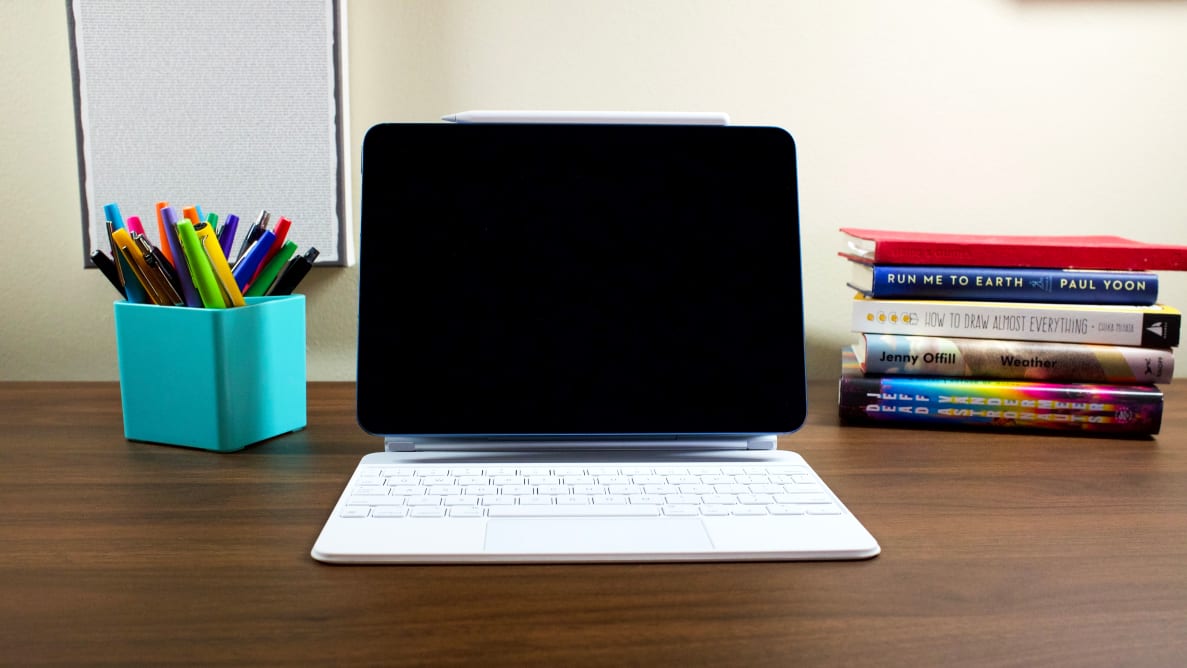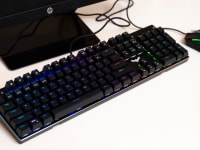Pros
-
Similar experience to iPad Pro
-
Snappy performance
-
All-day battery life
Cons
-
TouchID isn't as good as FaceID
-
Base model isn't good value
-
Flimsy back panel
About the M1 iPad Air
Here's a quick look at the tablet we tested:
- Chipset: Apple M1 (8-core CPU/8-core GPU)
- Display: 10.9-inch Retina LCD
- RAM: 8GB
- Storage: 64GB, 256GB
- Rear-facing camera: 12MP wide
- Front-facing camera: 12MP ultrawide
- Wired connectivity: USB-C
- Wireless connectivity: Bluetooth 5, Wi-Fi 6, Cellular 5G/4G LTE
The latest iPad Air shares much of its design with the 2020 iPad Air: it has a 10.9-inch LED display with 64GB and 256GB storage options, dual-speaker stereo system, and compatibility with accessories like Apple's Pencil and Magic Keyboard, as well as third-party gear like Logitech's Combo Touch keyboard case. Our review unit came with 256GB of storage, as well as cellular connectivity.
What we like
Similar experience to the iPad Pro
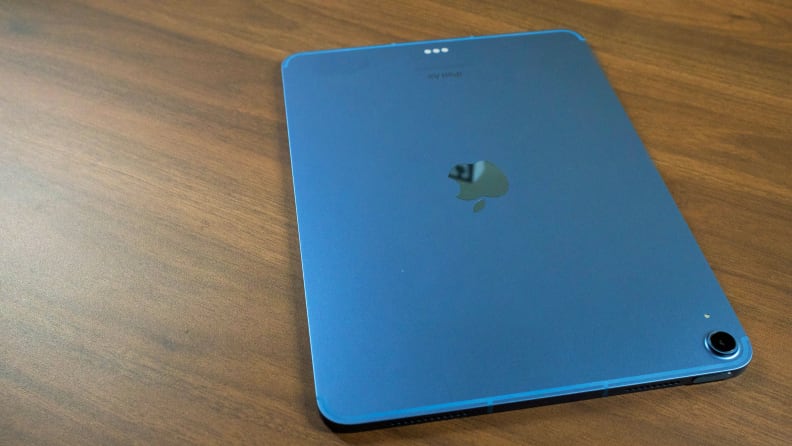
The M1 iPad Air is available in a new blue color that's eye-catching in person, but also touch to see once you've tossed a case onto your device.
The new iPad Air starts at $600 for the 64GB model without cellular, but you should splurge for the extra storage on the 256GB model (more on that later). That will bring the price up to $750—a high price for an okay amount of storage, but it's still $150 less than what’d you’d pay for an equivalent iPad Pro.
Both iPads feature the base M1 chip that powers Apple's latest computers, they both have 8GB of RAM (although the Pro has 16GB in the 1TB and 2TB models) and they're both compatible with the same accessories, like the Apple Pencil and Magic Keyboard, so either way you'll be working with the same tools, with mostly the same power backing them. In most cases, even third-party accessories like cases should be cross-compatible between the 11-inch iPad Pro and the M1 iPad Air.
Here's what you'll be missing with the M1 iPad Air: FaceID, an extra camera and a LiDAR sensor on the back, a few extra storage/RAM options, four-speaker audio (the Air has two speakers that work well enough), and the ability to pick any exciting colors other than Space Gray or Silver.
There are people who might miss those extra features, particularly creative professionals, but the M1 Air keeps most of the key features and all the fundamentals of the Pro into a similar package.
Snappy performance
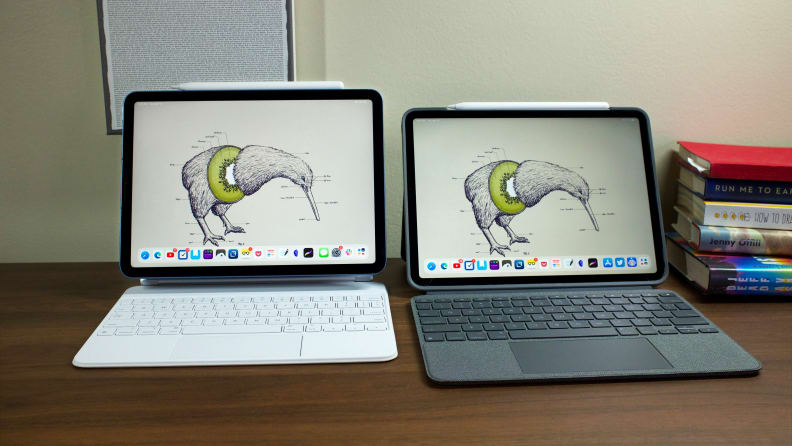
The M1 iPad Air is compatible with all the same accessories as the M1 iPad Pro, including Apple's Magic Keyboard and Logitech's Combo Touch.
Much has already been said about Apple's laptop-class M1 chip: It's fast, power consumption is low, and performance is solid enough for anything from web browsing and email triage to video editing or graphic design, all without taking too heavy a hit on battery life.
The 2020 iPad Air had Apple's six-core A14 Bionic chip, which had two high-performance cores and four high-efficiency cores, as well as four GPU cores. This year's iPad Air, which swaps the A14 for a fresh M1, has two extra high-performance cores and four additional GPU cores for a total of eight CPU cores and eight GPU cores.
Most people may not notice that extra boost in power, though. Apple Silicon has long been capable of running most tasks without breaking a sweat—that's nothing new here. To push the iPad Air, you'll have to delve into creative work or graphics-heavy gaming. Even there, the M1 proves more than capable on the iPad Air, as it has on every other device it's powered.
Even if you don't notice that extra boost, you'll still benefit from it. The M1 chip is plenty powerful, and Apple's track record indicates the new Air should get a few years' worth of software updates, so longevity shouldn't be an issue here.
Excellent battery life
Battery life hasn't been an issue on iPads for quite some time, and nothing's changed with the new iPad Air. On the days when I used the iPad Air for work, which included several hours in a text editor, with Slack occasionally in the multitasking window, and breaks to check email or browse the web, the iPad Air lasted about eight hours on a single charge.
On days when I mostly used the tablet for light browsing and some doodling in Procreate, I was able to get about ten hours of battery life. Even spending an hour or two streaming TV shows or movies won't kill the battery, and you'll still have enough juice to head out and work at a coffee shop.
What we don't like
TouchID isn't as good as FaceID
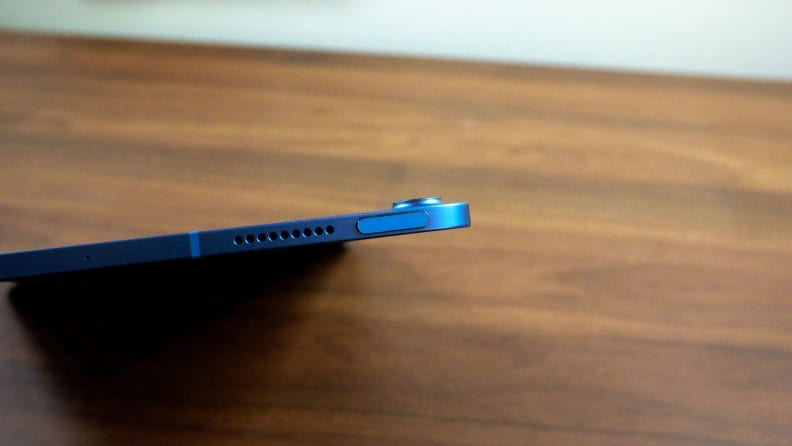
Since there's no FaceID on the iPad Air, Apple's brought back TouchID in its place. It's not as quick, and you'll have to move your hand every time you want to unlock the device, but it still works well.
Coming from my iPad Pro, there weren't many things I missed in testing the new iPad Air. However, after nearly a week of day-to-day use, I'm still not used to the TouchID-enabled power button on the iPad Air.
Where FaceID on the iPad Pro lets you unlock your iPad without having to do anything, you'll have to remember to reach over to your power button (which is placed on the far left corner of the screen when in portrait mode and docked into the Magic Keyboard) every time you want to unlock the device, make a purchase, or access secure information like your passwords.
When it works, it works well, but it's not as fast as FaceID. Since there's no circular home button on the new iPads, TouchID has been moved to the surface of the power button, meaning there's a smaller surface area to scan your fingerprint. I encountered only a few misfires, but it's still less convenient than FaceID's near-instantaneous, automatic unlocking.
The base model isn't the best value
Despite nearly everything about the M1 iPad Air being more than enough for most people, its base model isn’t a great value because of the amount of storage space. If you don't plan on doing much more than browsing the web and checking Twitter from your iPad, the 64GB might be enough to get you by, but that storage goes quickly.
If you need an iPad for more than casual browsing, like doodling, photo or video editing, or gaming, you should probably spend the extra money on the 256GB model. It might seem like a lot of storage if you're not a data hoarder, but since there's no middle-ground, 128GB option your choices are either just enough storage to get you by, or a drive that might never be full, but will always have room for more if you need it. That's worth the extra peace of mind, especially if you plan to keep your device for more than a year or two, but it's still an additional $150 on top of the base price.
And even with the M1 Air's low price, you still have to factor in any accessories you might need for what you plan to do with the iPad. The Magic Keyboard alone costs $200, and the second-generation Apple Pencil costs $130. If you opt for both, you're looking at a price tag of at least $950, which is within spitting distance of the entry-level M1 MacBook Air. Those devices have different use-cases (Macs run on a fully-fledged operating system, but there's no touch screen or stylus support), so it's worth considering the difference if you're looking to buy one machine for all your activities.
It's still limited by iPadOS
In theory, the iPad Air should be capable of handling most workloads. There's support for a keyboard and mouse, it has a desktop-class processor with plenty of oomph, and there's an app available for nearly any task you can toss at it. Despite all that, iPadOS still isn't well-equipped to make the most of all that power.
Sure, it has a file manager, though it's not nearly as robust as the one on macOS, and not every app works with the Files app the same way if there's support for it at all. iPadOS also isn't nearly as well-equipped for multitasking as desktop-class operating systems like Windows, macOS, or even ChromeOS.
You can slap two apps side-by-side and have another window hovering over those two, but even that's more limiting than what other systems offer. You can get the hang of this workflow, and there's certainly a lot you can do within the confines of iPadOS, but it's still way behind macOS or Windows.
It's also unfortunate that, despite being powered by the same class of chip as Apple's laptops and desktops, you still can't do things like use the iPad Pro with an external, second monitor. You can mirror your iPad's display to a second monitor if that's your jam, but you can't plug the Air into another display for more screen real estate.
The back panel is a bit flimsy

If you're precious about your gadgets, you'll want to plop a case on the M1 iPad Air, as applying pressure to the back of the device can cause the screen to distort.
If you’re planning on using the iPad Air mostly in tablet mode, you may want to toss a case onto it first. I noticed that applying a bit of pressure to some areas of the M1 Air’s back can cause the display to blotch. Pressing down on the right side will cause the right part of the display, just above where you pressed, to warp until the pressure is relieved. The right side of the display (the same spot as when you press on the right) will also warp if you press down on the left side of the Air’s back.
I confirmed this wasn’t unique to my review unit by testing it on another M1 iPad Air, and several redditors have noted this issue as well.
It’s certainly not pleasant to look at and can be alarming if you notice it in your own usage, especially if you’re worried that your $700 M1 iPad Air is already damaged. Once you relieve the pressure, the distortion will go away, and there doesn’t seem to be any lasting impact. But you may notice this more if you plan on using your iPad for illustration, note-taking, or anything else that requires a lot of stylus input. Even then, you probably won't notice this in day-to-day usage unless you're consistently applying a lot of pressure to your iPad's back, and it goes away quickly enough to not be much of an issue.
Should you buy it?
Yes, but go for the upgraded model with more storage
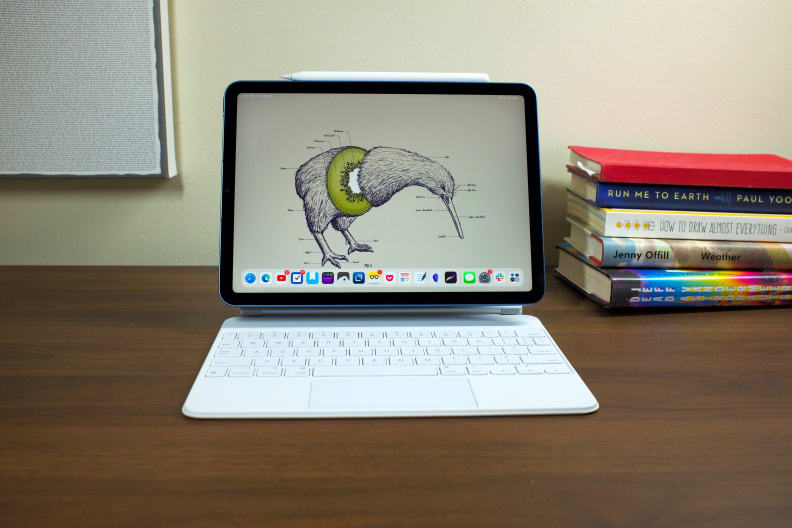
I'd like to say the base model iPad Air is the best iPad for most people; at $600 you'd have a hard time finding a more powerful tablet that could so easily switch between a tablet for leisurely browsing and a serious work utility as the new iPad Air. Unfortunately, that base model is held back by an underwhelming 64GB of storage.
If you're dedicated to cloud management and don't install a ton of apps or media on your devices, that might seem like a high limit. But apps get bigger in size as they're around longer (Facebook's app is now a whopping 255MB, YouTube's is 246MB), and storage management on iPadOS is nowhere near as robust as macOS, so you'll have to spend more time staying on top of that. If you plan on keeping your iPad for more than a couple of years, it's worth it to spare yourself the headache later and get the 256GB model.
The issues with the M1 Air’s back panel give some reason for pause, too. In my testing, this didn’t impact performance or the overall experience, and there hasn’t been any lasting damage, but it may still raise some concerns for users worried about longevity. If that doesn’t bother you, then you’ll have nothing to sweat. But if it does, you can either attach a case to the Air, or spring for the 11-inch Pro, though that’ll cost you an extra $150 for equivalent storage.
Caveats aside, the new iPad Air is a really good iPad, and minor adjustments to storage and quality control could make it even better. At $600 to start, it's a relatively low price for what you're getting: a stylus-ready tablet equipped with a laptop-class processor that provides all-day battery and snappy performance, plus a Retina display that's as good for movie watching as it is for photo editing or schoolwork, and access to the wide array of accessories available for the previous iPad Air, as well as the 11-inch iPad Pro. You may still be held back by the limitations of iPadOS, but if that doesn't scare you off, the iPad Air is plenty of machine for most people.
Meet the tester

Jordan McMahon
Staff Writer, Electronics
Jordan has been writing about and reviewing technology since 2017, with products ranging from tablets and apps to fanny packs and home office gear.
Checking our work.
Our team is here for one purpose: to help you buy the best stuff and love what you own. Our writers, editors, and lab technicians obsess over the products we cover to make sure you're confident and satisfied. Have a different opinion about something we recommend? Email us and we'll compare notes.
Shoot us an email

